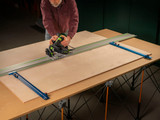Workshop Organization Guide: Storage Solutions & Layout Tips
If there’s one thing I’ve learned as a woodworker, it’s that your workshop organization is never truly "done." No matter how dialed-in your setup seems today, a new tool, a new project, or just a better way of doing things will inevitably send you back to the drawing board. And honestly, that’s part of the fun. A well-organized shop isn’t just about keeping things tidy—it’s about making sure your storage solutions works with you, not against you.
In this guide, I’ll walk through practical, real-world solutions for tool storage, shop layout, and power management—solutions that work in an actual workshop, not just for Instagram photos. Whether you have a sprawling workspace, a one-car garage, or a compact woodworking shop, these ideas will help you maximize floor space, store power tools efficiently, and optimize workflow so your work area stays functional and your tools are always within reach when you need them.
Woodshop Storage: Finding a Place for Everything
Storage is where it all starts, no matter the size of your work area. Whether you’ve got a dedicated shop or you’re cramming tools into a one-car garage alongside the lawnmower, keeping things organized means you spend less time searching for hand tools, power tools, and accessories and more time actually working on projects.
Most tools come in their own cases, but stacking them makes access difficult—especially when you need one in the middle. A deep drawer storage cabinet or a SysCart solves this by adding pull-out drawers, keeping every Systainer accessible without the hassle of unstacking.
Building a SysCart
For a straightforward build, TSO Products offers SysPort Plans that provide a tested, efficient design. Whether you prefer a DIY approach or a ready-made solution, the right drawer system or drawer system makes all the difference:
- SYS-AZ Drawers – Full-extension slides let you pull out the entire Systainer.
- Systainer³ SYS3-SN/4 Rails – A lower-cost option, but without full-extension support.
- 3D Printed Systainer3 Rails - If you own a 3D printer, this is a solid option for drawer slides that extend far enough so that you can open the lid and access its contents.
- Custom Drawer Boxes & Slides – A flexible, fully DIY solution.
Stacking vs. Pull-Out Access
The TANOS Systainer³ CART - SYS-RB makes it easy to move a stack of Systainers, but accessing anything beyond the top means unstacking first. A SysCart with pull-out drawers eliminates that problem, keeping tool storage organized and within reach.
Organizing the Rest of Your Shop
For the DIY crowd, there are tons of storage plans out there. The MWA Woodworks Shop Storage Plan Bundle is a solid place to start, or if you’re feeling adventurous, Pinterest can send you down a rabbit hole of ideas. Whether you go for classic pegboards, magnetic tool holders, a clamp rack for securing clamps, or modular shelving, the key is making your storage work for you.
Personally, my wife—who is far more organized than I am—designed the storage setup in my first home workshop. It’s a simple garage-level workbench with a rollout tool cabinet underneath, providing extra storage space and workspace when I need it. If you’re in the same boat with a partner who thinks garages are meant for cars instead of tools, this kind of setup is a solid compromise.
Shop Layout: Adapting to an Evolving Workspace
If I’ve learned anything about shop layout, it’s this: as soon as you think you’ve got it perfect, you’ll get a new tool or take on a new type of project that forces you to rethink everything.
That said, some guiding principles help:
- Wall storage is your friend. The more tools you can get off the floor, the more floor space you have for larger workpieces and a miter saw station.
- Leave room for workflow. If you can’t feed a long board through your table saw without hitting a bench or wall, something needs to move.
- Flexibility is key. Mobile workbenches, fold-up surfaces, and modular tool stations can help you adapt your space to different tasks, especially if you're working in a small space.
I dream of a shop where I have ample outfeed space for my table saw, proper storage for every hand tool, and enough room to actually walk between stations. Reality? My shop is a work in progress—just like everyone else’s.
One of the biggest game-changers for space efficiency is using a 20mm hole workbench system with Power-Loc Bench Connector Dogs. Instead of dedicating separate workstations to your router, bench grinder, and vise, you can mount them on jigs and swap them in and out as needed. A BORA Centipede tabletop with dog holes is another great option if you need a mobile, space-saving solution.
For bigger storage needs, a mobile tool storage cabinet is a lifesaver. If you’ve ever tried to lug a bench grinder across the shop, you know why having a rolling solution makes life easier.
Power Management: Keeping Cords in Check
No matter how much extra space you have, power management can make or break your workflow. Nobody wants to be tripping over extension cords—or worse, realizing you’re out of outlets just as you need to fire up a power tool.
One of the coolest solutions I’ve seen is overhead power tracks, which let you drop outlets exactly where you need them—perfect for keeping your workbench, dust collection system, and tools powered without cluttering the floor.
If rewiring your shop isn’t an option, an extension cord management system can still keep things under control. The QuickWinder RAP-100 is a slick option that keeps your cords neatly wound and easy to deploy, with a sturdy base that can even be wall-mounted.
The goal is simple: no more tangled cords, no more tripping hazards, and no more fighting to find an open outlet mid-project.
Building Your Ideal Workshop
At the end of the day, every woodworker’s shop is unique. Whether you’re a weekend hobbyist or running a small production shop, the key is designing a space that works for you.
TSO has some great solutions to help, but the best shop layout is the one that evolves with you over time. Start with smart storage solutions, think through your workflow, and don’t be afraid to tweak things as you go. Because let’s be honest—no matter how organized we try to be, a little sawdust on the floor just means the shop is getting used the way it should be.
Recent Posts
-
What Size Guide Rail Do I Need? Choosing the Right Length (and When to Use Extensions)
The scenario: you need to make a cut in that full size plywood panel sitting in the corner of your s …6th Nov 2025 -
Best Track Saw Systems: Expert Review & Advice
The track saw market has changed considerably over the past three years. Back then, your options wer …6th Nov 2025 -
Systainer Storage Guide: Organize Your Workshop Tools
Picture this: you're setting up for what should be a straightforward series of cuts, but you can't l …2nd Sep 2025




